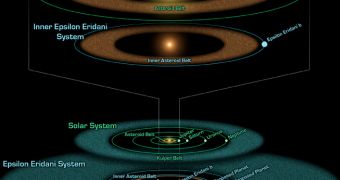The relentless search for new life-hosting planets has received a new boost from a recently-found star system located close to ours in astronomical terms. It looks a lot like our own did, back in the time life appeared on Earth, but a planet that would actually be appropriately placed is yet to be found. The system is called Epsilon Eridani, and is placed about 10.5 light years away from the Sun. According to the experts at the Search for Extraterrestrial Intelligence (SETI) Institute and from the Harvard-Smithsonian Center for Astrophysics, it is surrounded by two planet-shaped inner asteroid belts.
The solar system itself has such an inner asteroid belt located between Mars and Jupiter, hiding the 4 innermost planets – Mercury, Venus, Earth and Mars. Similarly, the belts of our neighbor system could be shielding some Earth-like planets from view. As Dana Backman from SETI stated in a press release, “This system probably looks a lot like ours did when life first took root on Earth,” when the Kuiper Belt was far bigger than it is today. Until about 4 billion years ago, Kuiper Belt Objects (KBOs) kept falling into the inner system, affecting it, such as a KBO is believed to have created our Moon as a result of an impact.
There is no reason why Epsilon Eridani shouldn't behave pretty much the same, especially considering that its outer belt is almost identical to the ancient Kuiper one. This could lead to the proper placement of a currently hidden planet in the fragile range where the system's star provides life-supporting conditions, just like on Earth. Based on the information gathered from the mutual impact on the Kuiper Belt of the solar system, the shape of the asteroid belts from Epsilon Eridani have led astrophysicists to conclude the possible location and size of 3 planets.
The first one (Epsilon Eridani b), theoretically lies at what would be the middle of the distance between Mars and Jupiter in our solar system, while the other two reside somewhat farther from their own star, at a distance like that between Uranus and Neptune, respectively, and the Sun. Since the current observation methods are not strong enough to protrude the mysteries of the nearby system, an accurate conclusion will have to wait until more sophisticated technology will be able to scan it thoroughly.

 14 DAY TRIAL //
14 DAY TRIAL //